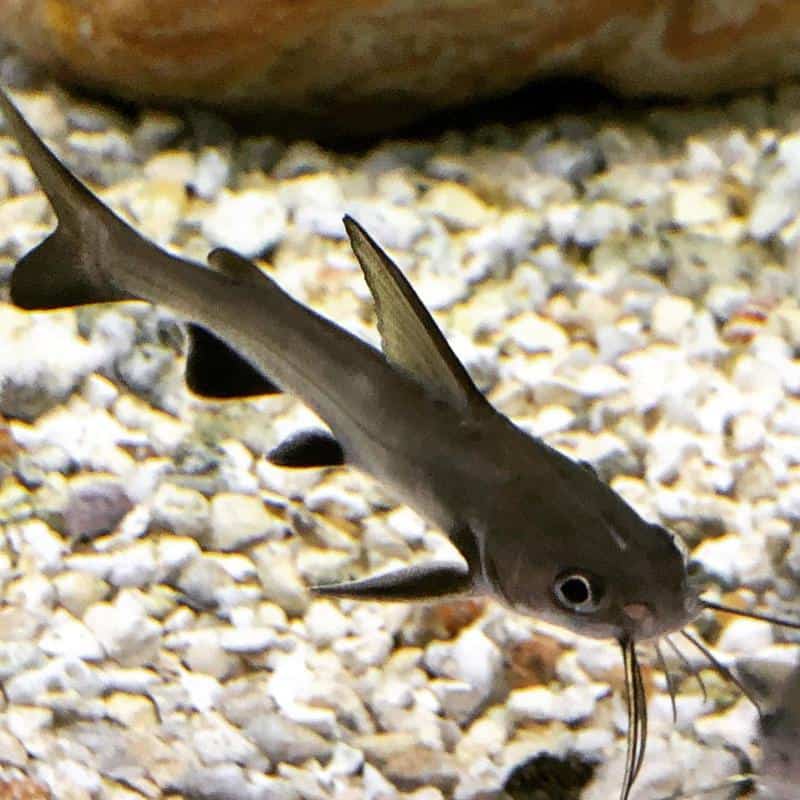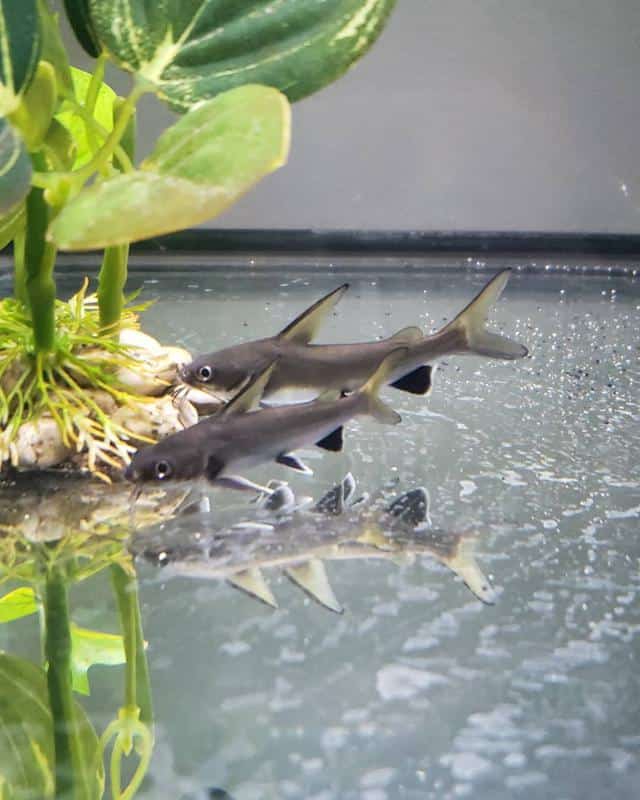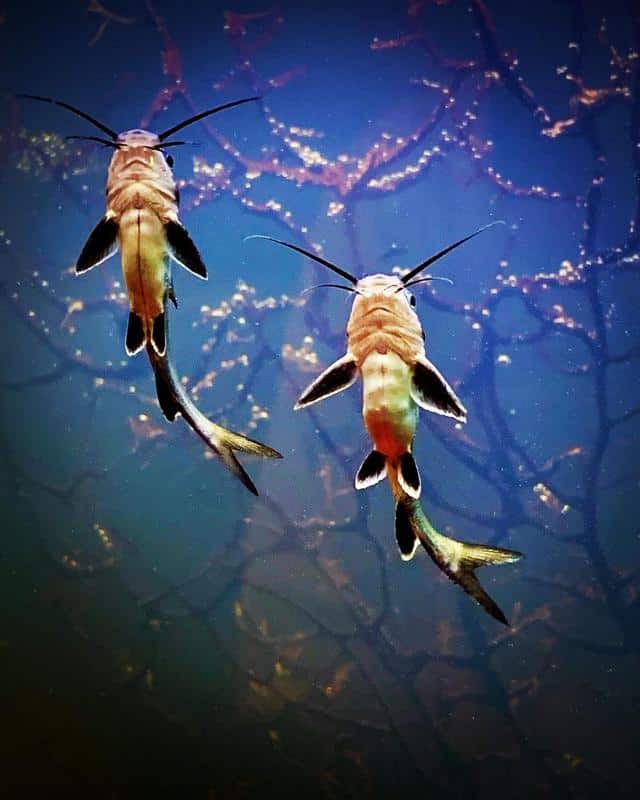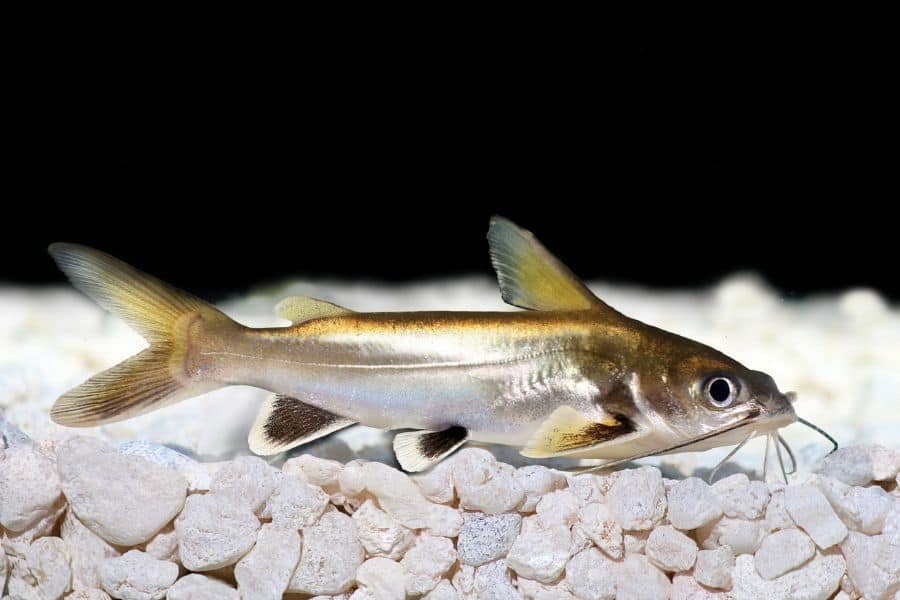Compared to other aquarium fish, Columbian Sharks are not as attractive, especially when you see them in a pet shop full of aquarium displays. In most cases, we spend more time looking at brightly-colored fish and often neglect dull-toned fish like the Columbian Sharks.
That was also my impression when I first saw their brown-colored bodies with faint horizontal stripes, and thought it could be one of the reasons why they are underrated.
Despite not being a mainstream fish in the industry, I cannot help but wonder why they are being sought after by experienced aquarists.
After years of keeping my now fully-grown Columbian Shark, here’s what I discovered.
Columbian Shark(Silvertip Shark Catfish) Characteristics
A Shark-looking Catfish
The moment I saw their whiskers (also called barbels), I immediately associated them with catfish. Yes, Columbian Sharks (Ariopsis seemanni) fall under Order Siluriformes to which all catfish belong.
Columbian Sharks are not real sharks like the large oceanic predator we all fear. The reason why they bear a shark name is because of their tall triangular dorsal fin that is similar to those of real sharks.
Similarly, their pectoral, pelvic, and anal fin spreads out when they swim which is pretty much shark behavior.
Absence of Scales
When we think of fish, we often assume they have scales. But this is not the case for Columbian Sharks. Like most species of catfish, Columbian sharks are scaleless making them vulnerable to physical skin injury, damage and diseases.
In the absence of scales, Columbian Sharks can still protect themselves against competitors, predators, and skin-related illnesses through their two evolutionary traits.
First, their skin is thick and tough like leather. Its reinforced dermal coating protects them against cuts and abrasions that could lead to infection if not treated and healed.
Second, the skin of Columbian Sharks has a thick layer of mucus. This slimy coat prevents their skin from direct contact with the water, thus giving them a protective shield against bacteria, viruses, and parasites.
Venomous Dorsal Spines
We know we got your attention when we mentioned that the skin of a Columbian Shark is slimy. The tendency after knowing this is that you will hold them and feel how slimy their skin is.
Touching and making direct hand contact with Columbian Sharks is NOT recommended for 2 reasons.
First, you will scrape a portion of their slime and reduce their level of skin protection.
Second, you may accidentally touch their highly pointed dorsal fin that is connected to a venom gland. The moment your hands come in direct contact, their dorsal spines punctures your skin and injects a traumatogenic toxin. The good news is that it is not fatal and the intensity of pain, as mostly described, is like a bee sting. However, in my case that I have a low tolerance to pain, it is swellingly excruciating.
Decade-long Lifespan
In captivity, the lifespan of Columbian Sharks is anywhere from 10 to 15 years. With the care we give them and the controlled environment we provide, you can expect your fish to live for at least a decade.
But surprisingly, they live longer in their wild habitat in Central and South America, even if it is heavily damaged by human activities.
Different Common Names
Ariopsis seemanni is popularly and commonly called the Columbian Shark Catfish (or Silvertip Shark catfish) in the aquarium industry.
However, with regional variation, this fish has earned less-popular names like Jordan’s Catfish and Tete Sea Catfish. So do not be surprised if different pet shops tag them with different names.
Often Sold as Juveniles
With a total length ranging from 3 to 6 inches (8 to 15 cm), Columbian Sharks that are usually sold in pet shops are juvenile, and managing them at this stage is easy.
However, be aware that they can triple their size as they reach sexual maturity. It means that after 2 to 3 years, they can grow anywhere from 10 to 14 inches (25 to 36 cm) in length.
In the case of my friend where he gave the best care and condition, his Columbian Shark reached 20 inches or half a meter long.
Different Life Stages and Their Salinity Preference

Some aquarists are disappointed with the stunted growth of their Columbian Sharks and many have experienced this fish not living up to its expectations. Many have argued that these fish are freshwater, while some suggest they are brackish water. Well, both are correct, but depending on their life stages.
We have to remember that in their wild habitat, Columbian Sharks thrive in freshwater tributaries that empty into an oceanic environment, and their different life stages are subjected to varying salinity.
Adult-breeding Columbian Sharks prefer to stay in brackishwater environments – an area where saltwater and freshwater meet. For comparison in salinity, freshwater has 0 ppt, brackishwater averages at 20 ppt, and seawater ranges from 33 to 35 ppt.
Their eggs are laid and larvae are hatched in the same brackish water ecosystem. However, as they grow into a juvenile, they migrate upstream in pure freshwater habitats like lakes and streams. As they grow old and reach sexual maturity, they slowly go downstream back to brackish water, and the cycle repeats itself.
Growth Requirements

Potentially growing into a large fish and its complexity in keeping up with its water parameters, Columbian Sharks are ideal for experienced aquarists. But if you know their preference, then you may be able to keep them and allow the fish to live up to its expectation.
100-gallon Tank for a Small School
Even if you purchase juvenile Columbian Sharks in a pet shop, it is important that you use a large tank right at the very start. While their ideal stocking density is 1 fish for every 75 gallons of water, you must at least use a 100-gallon tank (the bigger the better). But why?
First, you will be keeping not just one fish, and a small school of at least 5 fish is often the setup. Second, aside from potentially growing to a large fish, Columbian Sharks are active swimmers and need ample space to swim and grow.
In case you keep them in a smaller tank, then expect a stunted growth.
Hard Water
The wild aquatic habitat of Columbian Sharks is loaded up with minerals, contributing to water hardness which measures anywhere from 10 to 12 dGH. You must maintain the hardness level within the range especially if your Columbian Sharks are still juveniles.
If you still don’t know your water hardness level, you can measure it using a test kit. If the reading is below the range (often the case of tap water), it means that your water is soft. You can add agents (like crushed corals and mineral additives that contain calcium and magnesium) to increase water hardness.
Moderate to Strong Water Flow
Columbian Sharks are river fish. It means that they live in fast-flowing waters. Simulating this type of condition in your tank will not just make your fish happy, but also facilitate their growth and development.
In this particular parameter, you can really see its effect on your fish. When you place your Columbian Shark in stagnant waters, they will become bored and their swimming activity decreases. However, when you increase water flow (ideally from moderate to strong flow), you will see your fish becoming active and more vibrant.
Fresh to Brackish
Perhaps, of all the parameters that you need to address over the period of keeping your Columbian Shark is salinity. On the assumption that you purchase a juvenile fish, it is okay that you initially start with total freshwater. But as they grow, you need to mimic their migration back to brackishwater.
A few months after your juvenile Columbian Sharks have adjusted to their tank, you can increase the salinity to 1.002 specific gravity. Use a portable refractometer to measure salinity (that can also be expressed in ppt or part per thousand). As they reach sexual maturity after 2 years, slowly bring up the salinity to 1.01 specific gravity.
Now, how do you increase salinity in your tank? Please do not try adding pure ocean or seawater. Otherwise, you will be bringing bacteria and other pathogens where the consequence is fatal to your fish. Instead, use saltwater mix and add small portions overtime, slowly increasing your salinity and giving your fish time to adjust.
Summary of Columbian Shark Growth Requirements
| Parameters | Range |
| Minimum Tank Size | 100 gallons |
| Stocking Density | 1 fish / 75 gallons |
| Temperature | 25 to 27 C (75 to 80 F) |
| Water flow | Moderate to Strong |
| pH | 7.0 – 8.0 |
| Hardness | 10 to 12 dGH |
| Salinity | 1.002 (juvenile) / (1.01 adult) |
Feeding Behavior and Requirements
Omnivorous Scavenger
Being an omnivore, Columbian Sharks are not picky eaters. Even if they swim constantly in midwater, they scour the substrate for any food, making them an omnivorous scavenger.
In the wild, the food items of Columbian Sharks include algae, aquatic plants, shrimps, and crustaceans. While keeping them in your tank, you can give them fish flakes, sinking pellets, earthworms, and frozen foods.
The 5-minute rule
When we feed our fish, we usually use the 2-minute rule allowing them to consume anything within that time frame. However, with the huge appetite of Columbian Sharks plus their constant need for energy in swimming, 2 minutes is not enough.
Increase their feeding time to 5 minutes. For juveniles, you can feed them thrice a day, and twice for adults.
High Prey Drive to Smaller Fish
When you underfeed your Columbian Shark, the tendency is that hunger will trigger their prey drive and will look for any available food in the tank.
In most cases, smaller fish present in your tank will become a substitute meal if you don’t feed them well.
Breeding and Propagation

Unless you have a sophisticated system that increases and decreases salinity, then breeding Columbian Sharks can become extremely difficult.
Sexually Monomorphic
Unlike the sexual dimorphism in Guppies where the males look different from the females, Columbian Sharks are sexually monomorphic. It means male and female Columbian Sharks look the same, making gender identification difficult.
Nevertheless, the males are generally smaller in size while the females have a round and robust body shape.
Courtship and Mating
As earlier mentioned, Columbian Sharks reach sexual maturity when they reach 2 to 3 years old. When they are sexually mature, environmental conditions (like changes in temperature and other parameters) trigger mating.
During this time, males become highly active as they chase the females during courtship. Aside from chasing, the males will try to bump the females, particularly in their stomachs to trigger the release of eggs.
Paternal Mouthbrooder
Once the eggs are released, the males will fertilize them externally.
Here’s the thing with Columbian Sharks, and do not be shocked to see this. Males will take in the fertilized eggs in their mouths.
But make no mistake of considering this as cannibalism as Columbian Sharks are parental mouthbrooders. It means that the males carry on the fertilized eggs in their mouths until they hatch.
Ideal Tank Mates
Selecting the ideal tank mates for your Columbian Shark can be tricky since they should be similar in size and water parameters. Otherwise, if the tank mate you choose does meet the 2 criteria, then they will either die from salinity difference or become food for your Columbian Shark.
Some of the proven tank mates for Columbian Sharks include Moony Fish, Archer Fish, and Scats.
Read More:
Columbian Sharks: FAQs
What Are Some Diseases Suffered by Columbian Sharks?
Columbian Sharks are hardy fish. However, if their preferred water conditions are not met (especially salinity), their immune system weakens and they become prone to diseases and infections like skin flukes, gill flukes, bacterial and fungal infections.
Are Colombian Sharks aggressive?
No, except during mating when the males are relatively active, and when they are hungry where they fiercely compete for food.
Final Thoughts
After reading this article and learning the complexities of Columbian Sharks, you will realize why they are not so popular and recommended only for experienced aquarists.
In my case, I was not an expert when I started keeping Columbian Sharks. But keeping them challenged me and made me improve my skills. Today, I am happy to share to you that my Columbian Sharks have reached sexual maturity.
But if you’re going to ask me if I am going to breed them, I guess I need to learn and improve more. But who knows. Find out in our next articles.
